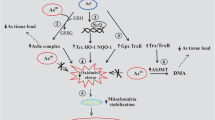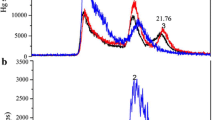Abstract
Mercury (Hg) is a common environmental toxicant to which humans are exposed regularly through occupational and dietary means. Although selenium supplementation has been reported to prevent the toxic effects of Hg in animals, the mechanisms for this prevention are not well understood. The purpose of the current study was to determine the effects of selenium on the disposition and toxicity of Hg. Wistar rats were injected intravenously with a non-nephrotoxic dose (0.5 μmol kg−1) or a nephrotoxic dose (2.5 μmol kg−1) of HgCl2 (containing radioactive Hg) with or without co-administration of sodium selenite (Na2SeO3). Twenty-four hours after exposure, rats were euthanized, and organs were harvested. Co-administration of SeO32− with HgCl2 reduced the renal burden of Hg and the urinary excretion of Hg while increasing the amount of Hg in blood and spleen. We propose that Hg reacts with reduced selenite in the blood to form large Hg–Se complexes that are unable to be filtered at the glomerulus. Consequently, these complexes remain in the blood and are able to accumulate in blood-rich organs. These complexes, which may have fewer toxic effects than other species of Hg, may be eliminated slowly over the course of weeks to months.







Similar content being viewed by others
References
Gibb H, O'Leary KG (2014) Mercury exposure and health impacts among individuals in the artisanal and small-scale gold mining community: a comprehensive review. Environ Health Perspect 122:667–672
EPA (2018) How people are exposed to mercury. US Environmental Protection Agency, Washington, D.C.
Asano S, Eto K, Kurisaki E, Gunji H, Hiraiwa K, Sato M, Sato H, Hasuike M, Hagiwara N, Wakasa H (2000) Review article: acute inorganic mercury vapor inhalation poisoning. Pathol Int 50:169–174
Vazquez M, Calatayud M, Velez D, Devesa V (2013) Intestinal transport of methylmercury and inorganic mercury in various models of Caco-2 and HT29-MTX cells. Toxicology 311:147–153
Vazquez M, Velez D, Devesa V, Puig S (2015) Participation of divalent cation transporter DMT1 in the uptake of inorganic mercury. Toxicology 331:119–124
Spiller HA (2018) Rethinking mercury: the role of selenium in the pathophysiology of mercury toxicity. Clin Toxicol (Phila) 56:313–326
Yu SY, Mao BL, Xiao P, Yu WP, Wang YL, Huang CZ, Chen WQ, Xuan XZ (1990) Intervention trial with selenium for the prevention of lung cancer among tin miners in Yunnan, China. A pilot study. Biol Trace Elem Res 24:105–108
Ralston NV, Raymond LJ (2010) Dietary selenium's protective effects against methylmercury toxicity. Toxicology 278:112–123
Binte Hossain KF, Rahman MM, Sikder MT, Saito T, Hosokawa T, Kurasaki M (2018) Inhibitory effects of selenium on cadmium-induced cytotoxicity in PC12 cells via regulating oxidative stress and apoptosis. Food Chem Toxicol 114:180–189
Bjorklund G (2015) Selenium as an antidote in the treatment of mercury intoxication. Biometals 28:605–614
Bjorklund G, Dadar M, Mutter J, Aaseth J (2017) The toxicology of mercury: current research and emerging trends. Environ Res 159:545–554
Khan MA, Wang F (2009) Mercury-selenium compounds and their toxicological significance: toward a molecular understanding of the mercury-selenium antagonism. Environ Toxicol Chem 28:1567–1577
Chen C, Yu H, Zhao J, Li B, Qu L, Liu S, Zhang P, Chai Z (2006) The roles of serum selenium and selenoproteins on mercury toxicity in environmental and occupational exposure. Environ Health Perspect 114:297–301
Zalups RK (2000) Molecular interactions with mercury in the kidney. Pharmacol Rev 52:113–143
Arnold AP, Tan KS, Rabenstein DL (1986) Nuclear magnetic resonance studies of the solution chemistry of metal complexes. 23. Complexation of methylmercury by selenohydryl-containing amino acids and related molecules. Inorg Chem 25:2433–2437
Chen RW, Whanger PD, Fang SC (1974) Diversion of mercury binding in rat tissues by selenium: a possible mechanism of protection. Pharmacol Res Commun 6:571–579
Li YF, Dong Z, Chen C, Li B, Gao Y, Qu L, Wang T, Fu X, Zhao Y, Chai Z (2012) Organic selenium supplementation increases mercury excretion and decreases oxidative damage in long-term mercury-exposed residents from Wanshan, China. Environ Sci Technol 46:11313–11318
Norseth T, Clarkson TW (1970) Studies on the biotransformation of 203Hg-labeled methyl mercury chloride in rats. Arch Environ Health 21:717–727
Norseth T, Clarkson TW (1970) Biotransformation of methylmercury salts in the rat studied by specific determination of inorganic mercury. Biochem Pharmacol 19:2775–2783
Norseth T, Clarkson TW (1971) Intestinal transport of 203Hg-labeled methyl mercury chloride. Role of biotransformation in rats. Arch Environ Health 22:568–577
Wang X, Wang WX (2017) Selenium induces the demethylation of mercury in marine fish. Environ Pollut 231:1543–1551
Lemke M, Gorl N, Berg A, Weber H, Hennighausen G, Merkord J (2006) Influence of selenium treatment on the acute toxicity of dibutyltin dichloride in rats. Pancreatology 6:486–496
Belanger M, Westin A, Barfuss DW (2001) Some health physics aspects of working with 203Hg in university research. Health Phys 80:S28–S30
Bridges CC, Bauch C, Verrey F, Zalups RK (2004) Mercuric conjugates of cysteine are transported by the amino acid transporter system b(0,+): implications of molecular mimicry. J Am Soc Nephrol 15:663–673
Lee HB, Blaufox MD (1985) Blood volume in the rat. J Nucl Med 26:72–76
Li X, Yin D, Yin J, Chen Q, Wang R (2014) Dietary selenium protect against redox-mediated immune suppression induced by methylmercury exposure. Food Chem Toxicol 72:169–177
Naganuma A, Imura N (1983) Mode of in vitro interaction of mercuric mercury with selenite to form high-molecular weight substance in rabbit blood. Chem Biol Interact 43:271–282
Naganuma A, Tabata J, Imura N (1982) A reaction product from mercuric mercury, selenite and reduced glutathione. Res Commun Chem Pathol Pharmacol 38:291–299
Naganuma A, Ishii Y, Imura N (1984) Effect of administration sequence of mercuric chloride and sodium selenite on their fates and toxicities in mice. Ecotoxicol Environ Saf 8:572–580
Watanabe C (2002) Modification of mercury toxicity by selenium: practical importance? Tohoku J Exp Med 196:71–77
Sakamoto M, Itai T, Yasutake A, Iwasaki T, Yasunaga G, Fujise Y, Nakamura M, Murata K, Chan HM, Domingo JL, Marumoto M (2015) Mercury speciation and selenium in toothed-whale muscles. Environ Res 143:55–61
Gajdosechova Z, Lawan MM, Urgast DS, Raab A, Scheckel KG, Lombi E, Kopittke PM, Loeschner K, Larsen EH, Woods G, Brownlow A, Read FL, Feldmann J, Krupp EM (2016) In vivo formation of natural HgSe nanoparticles in the liver and brain of pilot whales. Sci Rep 6:34361
Yoneda S, Suzuki KT (1997) Equimolar Hg-Se complex binds to selenoprotein P. Biochem Biophys Res Commun 231:7–11
Steiniger BS (2015) Human spleen microanatomy: why mice do not suffice. Immunology 145:334–346
Jakubovsky J, Brozman M, Ruzickova M, Surmikova E, Belko I, Liska J, Polak S, Sadlonova I, Belosovic M (1990) Structural basis of the spleen in rats. Bratisl Lek Listy 91:466–478
Vaupel P, Ruppert H, Hutten H (1977) Splenic blood flow and intrasplenic flow distribution in rats. Pflugers Arch 369:193–201
Daemen MJ, Thijssen HH, van Essen H, Vervoort-Peters HT, Prinzen FW, Struyker Boudier HA, Smits JF (1989) Liver blood flow measurement in the rat. The electromagnetic versus the microsphere and the clearance methods. J Pharmacol Methods 21:287–297
Braet F, Wisse E (2002) Structural and functional aspects of liver sinusoidal endothelial cell fenestrae: a review. Comp Hepatol 1:1
Schroeder B, McNiven MA (2014) Importance of endocytic pathways in liver function and disease. Compr Physiol 4:1403–1417
Forman HJ, Zhang H, Rinna A (2009) Glutathione: overview of its protective roles, measurement, and biosynthesis. Mol Asp Med 30:1–12
Henriques GS, Cozzolino SMS (2001) Determination of metallothionein levels in tissues of young rats fed zinc-enriched diets. Rev Nutr, Campinas 14:163–169
Piotrowski JK, Trojanowska B, Wisniewska-Knypl JM, Bolanowska W (1974) Mercury binding in the kidney and liver of rats repeatedly exposed to mercuric chloride: induction of metallothionein by mercury and cadmium. Toxicol Appl Pharmacol 27:11–19
Funding
The current study was funded by a grant from the Navicent Health Foundation.
Author information
Authors and Affiliations
Corresponding author
Additional information
Publisher’s Note
Springer Nature remains neutral with regard to jurisdictional claims in published maps and institutional affiliations.
Rights and permissions
About this article
Cite this article
Orr, S.E., George, H.S., Barnes, M.C. et al. Co-administration of Selenium with Inorganic Mercury Alters the Disposition of Mercuric Ions in Rats. Biol Trace Elem Res 195, 187–195 (2020). https://doi.org/10.1007/s12011-019-01835-y
Received:
Accepted:
Published:
Issue Date:
DOI: https://doi.org/10.1007/s12011-019-01835-y




